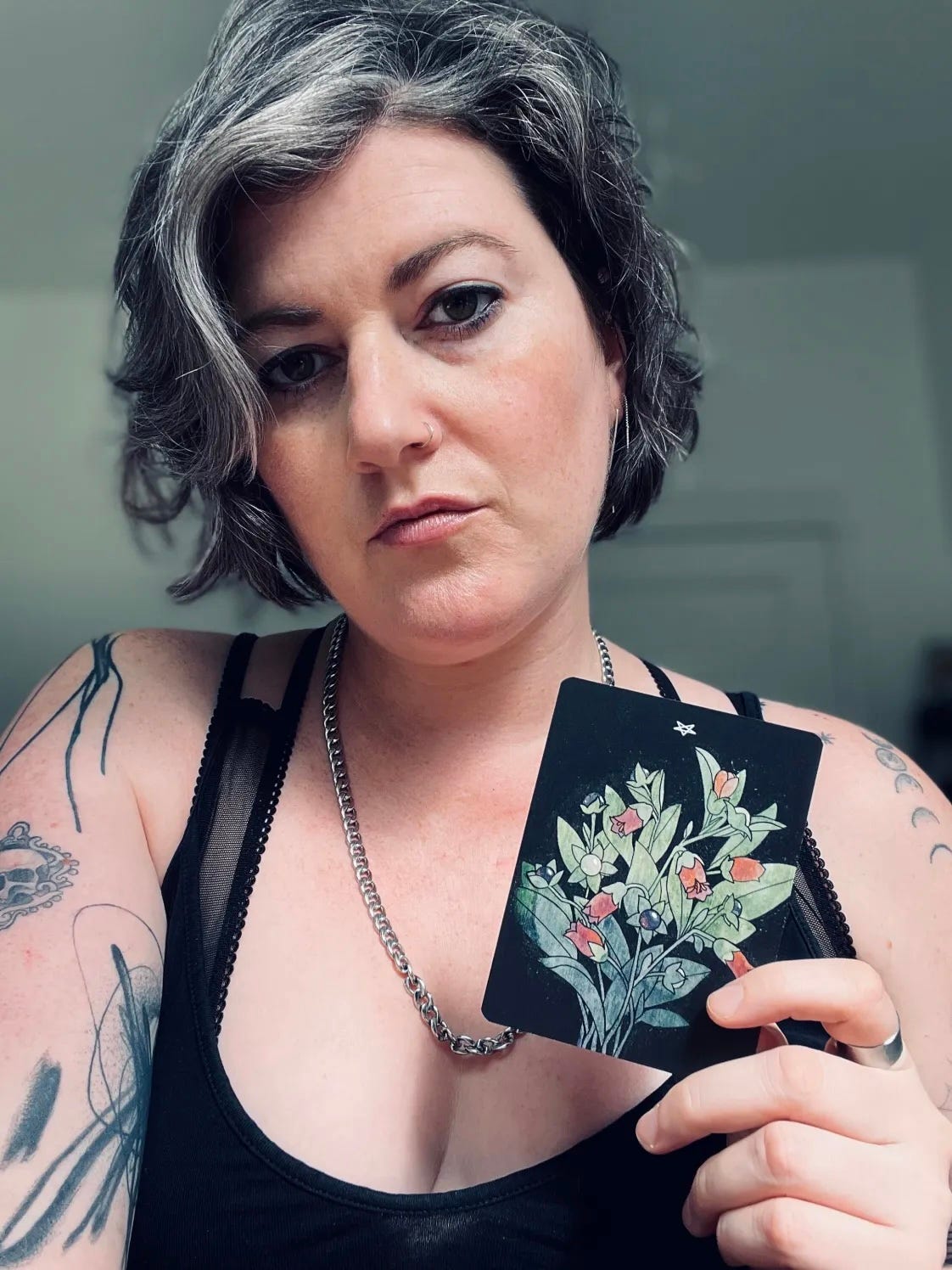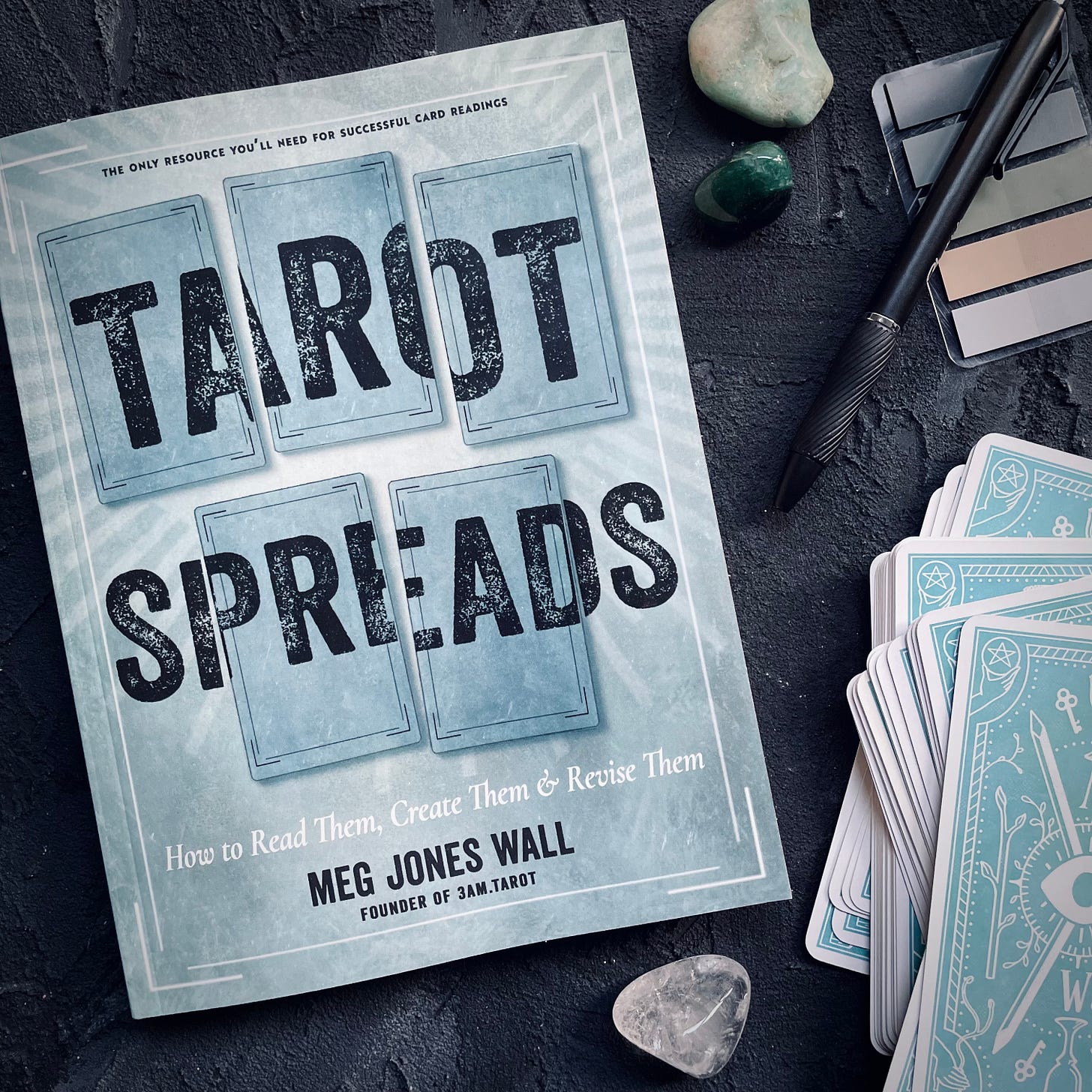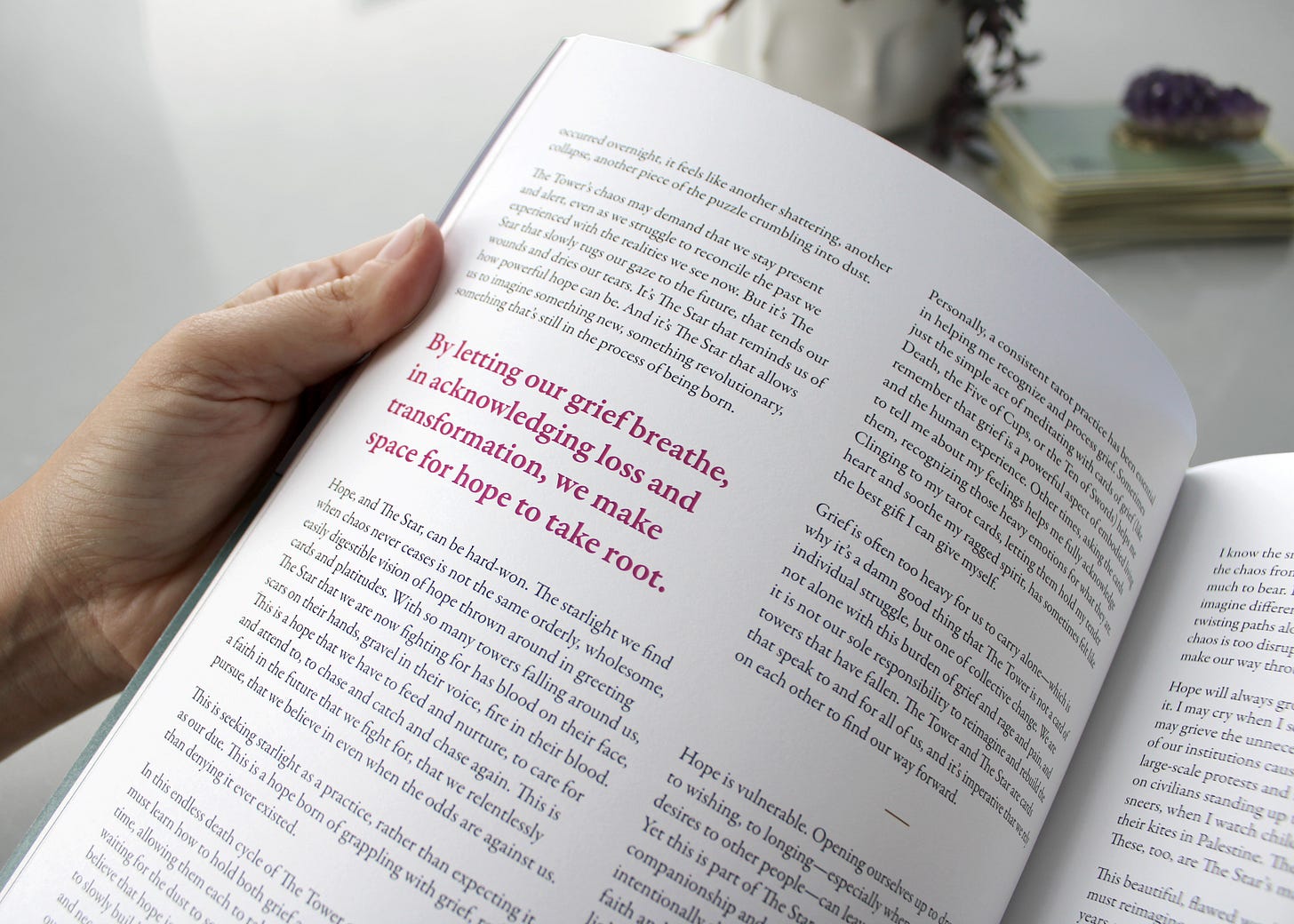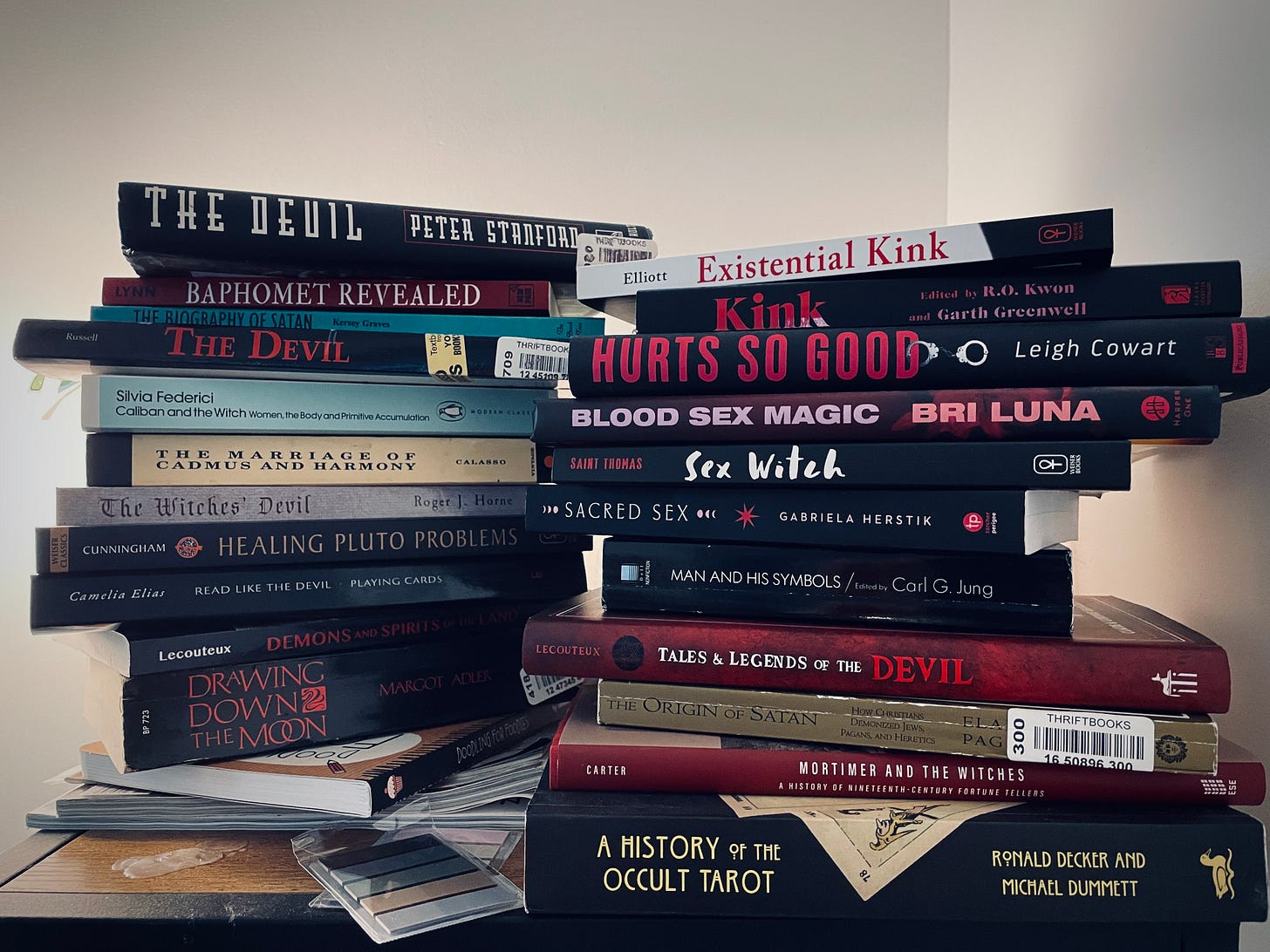Confronting The Devil
An interview with guest editor Meg Jones Wall on spiritual rebellion & the creative energy of tarot's most vulnerable card
Readers, friends, fellow tarot and literary enthusiasts—
I don’t have to explain why this is a time of deep reckoning. The Devil is everywhere. It asks us to confront our complicity, to see where we’ve been fooled, to question what freedom means. The Devil reveals and reveals and reveals.
Today, I’m sharing a conversation I had with the guest editor for our upcoming anthology, Meg Jones Wall, who’s currently writing a book about this powerful archetype. It’s been such an honor to collaborate with them on this issue.
Meg is a queer, chronically ill tarot reader and teacher who creates resources for spiritual misfits through their platform, 3am.tarot. They’re also the author of Finding the Fool: A Tarot Journey to Radical Transformation and Tarot Spreads: How to Read Them, Create Them, and Revise Them (July 2025). Meg has contributed to the past two issues of The Rebis (read an excerpt from their essay for The Star), and I’m thrilled to feature their editorial talents in a deeper way—they bring a sharp lens to this work, pushing past the discomfort of the archetype to make space for radical truth-telling.
Here, we talk about everything from escaping evangelical Christianity and purity culture to the power of queer ritual. Meg’s insights are thought-provoking and profoundly grounding.
The world is heavy with uncertainty and injustice, but making art together in community creates space for possibility—for imagining new futures, birthing new worlds. This has been the ethos of The Rebis since we launched in 2022. Connecting through art and spirituality helps us stay human when our governments seek to dehumanize. The contributors for The Devil anthology know this, and their stories show us all of the ways they reject control, reject conformity, reject isolation. We are finding each other in the dark and building something defiantly joyful.
This issue of The Rebis is a place where we name what’s broken (in ourselves, in our rotting empire). We descend—deliberately, collectively—into the underworld, and see what emerges, what gets reborn.
The issue is currently with our printers. It’ll be available Fall 2025.
—Hannah Levy, The Rebis founder & editor-in-chief
If you’re excited about what we’re creating, please consider sharing our Substack by hitting that little golden button above this text. With the disintegration of social media platforms for discovery, we rely on word of mouth for community growth. Thank you for your support!

Meg! We are so honored to have you as our guest editor for this issue of The Rebis, bringing all of your tarot expertise to the table. Why were you interested in working with us? Can you share how you’re approaching your editorial role?
I’m so honored to be a guest editor. I’ve admired The Rebis since the first time I saw it—it’s such a beautiful work of collaborative creativity, and such a powerful monument to how tarot shifts depending on who’s reading it.
Tarot is so deeply and wildly relational. It’s so much about the relationships we build with the cards, the relationships we build with individual decks, the relationships we build with individual archetypes or stories within the cards, and the ways that we find ourselves within the cards. There’s just so much beauty to unpack. The Rebis captures that by gathering different voices and mediums into one really beautiful package. It illustrates this part of my own tarot philosophy—that the cards can have intrinsic meaning, absolutely, but the magic comes from how we ourselves interpret and relate to each one of those cards. By giving so many people an opportunity to weigh in on and explore and dance with each of these archetypes, we really get to see just how wide and deep our relationship with every single card in the deck can be.
Also, I just love editing. It’s my favorite part of the process. I think there’s something really beautiful in allowing an idea to fully take up space on the page, and understanding the relationship between the creator and the creation. And it’s such a privilege to sit with someone in the vulnerability of an unpolished work—helping someone refine their vision and find the emotional truth of their work. Editing is so much about asking questions, teasing out what’s true, strengthening what’s already strong, and helping a piece come into its own, and those are really satisfying moments for me.

The Rebis is all about tarot and creativity. How do you define creativity and what influences your creative process?
Part of what makes art so magical, and so necessary, is that no matter how specific someone is in their storytelling (whether it’s writing or art), the people interacting with the piece will often still find themselves within that work. It’s part of human nature—to figure out where we see aspects of ourselves reflected and refracted.
Creativity is about connection and relationship. Whether we’re the ones creating or the ones witnessing something, it helps us engage more deeply with our own humanity. The process of making something, of being in relationship with what we’re creating—and then letting it be seen, be received, be loved or challenged or misunderstood—that’s sacred.
So for me, that is a really critical part of the editorial role for The Rebis and the editorial process: asking questions, teasing things out, finding the nuggets of truth within something that want to be expanded and explored in new ways… then, as the reader or the viewer, getting to reflect back the magic we see within a project let it change us. It’s all part of this messy soup that is the creative practice.
It’s a real honor to be trusted to work with so many incredibly talented writers and poets and photographers and visual artists and collage artists, and to get to work with this brilliant team behind the scenes. I’m so proud and pleased with what we’ve made, with how we’re bringing The Devil to life.
“The process of making something, of being in relationship with what we’re creating—and then letting it be seen, be received, be loved or challenged or misunderstood—that’s sacred.”
Switching gears a bit—you’ve written a lot about your religious upbringing, leaving the church, and your path to discovering tarot. How did your evangelical background impact your current tarot practice?
I don't know how to talk about my tarot practice—past, present, or future—without also talking about my evangelical background. Growing up as the child of church planters and the grandchild of ministers and missionaries, the language and structure of Christianity shaped my entire worldview. It was the foundation for how I understood community, power, morality, and divinity, and was difficult to release even after I walked away from the church. That kind of theology and cosmic philosophy was the framework that I came to tarot with, and it created some challenges that ultimately made my practice and intuitive skills much stronger.
Tarot entered my life as one of my first real spiritual rebellions. I was almost 30 when I bought my first deck in 2016. It was a real effort to carve out a path to spirituality that wasn’t based in the religion I was raised with. I talk about this a lot because I think there are a number of folks like me, raised in high-control religions or fundamentalist worldviews, who wonder whether tarot is accessible to them or if it’s inherently evil. If you search online for "Christianity and tarot," you'll initially find articles about witchcraft, Satan worship, and the evils of fortune telling. For me, it became really important to tease apart religion from spirituality. The more I explored tarot, the more I found that it offered a spiritual framework that made space for intuition, autonomy, and complexity—things that had been missing in my religious upbringing, and that I was really craving.
My tarot practice began as an experiment, but it quickly became a spiritual anchor. When I first got my tarot deck, I thought I needed to follow all the “rules,” but I quickly ran into traditions I didn’t like or understand. Choosing to break those rules—not using the Rider-Waite-Smith deck, not using prescribed spreads, not memorizing fixed card meanings—all of that was critical to understanding who I am, what rebellion looks like, and how I want to live. In that way, tarot became a reclamation of spiritual agency.
I’ve had so many people who also grew up in high-control environments tell me how much they appreciate hearing my story. I know not everyone who reads tarot or calls themselves a witch has that kind of background, but it's important for me to keep talking about it. I want people who are in that messy moment of wondering if tarot is safe or okay to know they’re not alone. It's possible to have a strong tarot practice and still have a sense of spiritual self. You can create a relationship with your cards, with deities and spirits, with larger entities, or with ancestors, and it can be good, and beautiful, and sacred.
There are still threads of ritual and reverence that I carry with me from my evangelical roots, but now they're woven into a personal practice that is fluid, irreverent, and liberatory. I think that's the connection—tarot helped me break free from the parts of religion that harmed me, while also helping me hold onto the parts of my experience with the divine that still feel magical.

The Devil often evokes stories of evil, sin, and temptation—which so often get presented in opposition to purity and goodness. You’ve written about recovering from the Church and purity culture yourself. How did you form a healthier relationship to your deepest desires, and to behavior that you might have once thought was “sinful”?
I was raised with very restrictive ideas about gender, sexuality, and what makes relationships holy. I’m queer and nonbinary, and for the first 30 years of my life, I was told that these identities are inherently sinful, and that to choose them anyway meant that I was turning away from God. So for me, a lot of this process has been about self-reclamation, and about recognizing that queerness is sacred and holy. Embracing that has opened up new pathways to understanding desire not as bad, but as beautiful.
Purity culture teaches that pleasure is dangerous, that joy is something to fear. It trains you to police your thoughts, your body, your instincts. The Devil as an archetype gives us a way to reject that. So much of purity culture is about control and repression, but tarot and The Devil helped me start asking: What do I actually want? What feels like love? What feels like freedom? And slowly, gently, I started letting myself believe that those things were okay. That I was okay.
“Tarot helped me break free from the parts of religion that harmed me, while also helping me hold onto the parts of my experience with the divine that still feel magical.”
You’ve had such a rich journey! How has your perspective on tarot evolved since you first started practicing?
My perspective on tarot continues to expand. Every time I work with the cards or talk with someone about their practice, it just gets bigger. I love talking to people about how they interpret the cards, what correspondences they use, how they find meaning in card combinations, what their personal rituals are, what their relationships to individual cards are, and so much more.
Without fail, every time I read someone’s perspective or talk to someone about tarot, I learn something new. That’s what keeps me coming back to it—the endless depths. Tarot is like any good myth or fairy tale that keeps getting retold, re-spun, modernized in new ways, brought into different cultures and time periods. Every new interpretation or artwork reveals something new, and that in and of itself feels sa too.
Our fourth anthology is all about The Devil—which you’re writing a book about! Can you describe your project?
The book—which will be my third!—is called The Devils We Know, and it’s broken down into 15 essays, each looking at broader perceptions of The Devil through different lenses, then mapping that onto how we might understand the Devil tarot card. There are essays on psychology—Freud and Jung and the shadow—as well as on religious history, witchcraft, poison plants, Lucifer, the origins of Satan, folklore, and more. I’m trying to do justice to some really big ideas and trace those through-lines into modern and contemporary interpretations of The Devil within the tarot, as a way of introducing the many faces of this archetype. Thinking about things like kink and BDSM, pleasure, addiction—so many different ways of interpreting the Devil card, and tracing where those ideas came from.
I’ve always thought The Devil was one of the most personal, intimate, personally vulnerable, deeply human cards in the deck, and I feel that even more now. It means something so different to everyone. For some, The Devil means danger, temptation, bondage, sin. For others, it’s rebellion, freedom, pleasure, breaking habits. It can be all of that and more. It can be hedonism, it can be chaos, it can be patterns that harm us, or patterns that liberate us. And that’s why I love it—because it makes people uncomfortable, and it forces us to get real.
The way someone interprets this card says a lot about their background, what they’re willing to examine closely, what makes them comfortable or uncomfortable. It’s a card of exposure, in many ways. It challenges us to be brutally honest with ourselves—or to at least recognize when we’re unwilling to be.
Writing The Devils We Know has deepened my relationship to the card in every way. It’s humbling to explore just how layered this archetype is.

Your first book, Finding the Fool: A Tarot Journey to Radical Transformation, references the connection between The Devil and The Lovers. What lessons do you think these two cards offer when paired together?
I love numerology! I think the connection between The Devil and The Lovers—numerologically and in terms of imagery—is one of the most talked about mirrors in the Major Arcana. The Lovers (card 6) and The Devil (card 15, 1+5=6) are part of the same constellation, as Mary K. Greer calls it. The Devil and The Lovers both explore ideas of care and devotion, of responsibility, of connection, of choice.
The Lovers is often seen as an external card—how we connect with others, how we show up in relationship, what we give and receive, how we love and let ourselves be loved. The Devil, in contrast, can be about our internal relationships and internal mysteries—our shadows, our desires, our fears, our cravings. The Lovers can ask, What do we owe each other? How do we share what we have so we can all be stronger? and The Devil can ask, What do we owe ourselves? What do we allow to take up space within and around us? How honest are we being about what we want? How afraid are we to want something? I think they’re both cards of authenticity, but they challenge us in different ways.
Final question: Do you have any favorite pieces of art or writing that you feel connect with the archetype of The Devil?
Two books that I read in college always come to mind when I think about The Devil: Good Omens by Terry Pratchett and Neil Gaiman, and Jitterbug Perfume by Tom Robbins.
Good Omens is about the apocalypse, demons and angels, and it’s got this playful trickster energy around fucking with fate and rebelling against the powers that be. I know we hate Neil Gaiman now, but that book is still one of my favorites. Crowley, one of the main characters (who is also a demon) captures something I love about The Devil archetype in his desire to be a cagey badass while also actually protecting the people and places and ideas (and angels) that he loves.
Jitterbug Perfume features Pan as a major character—and Pan, like Dionysus, really captures the spirit of The Devil in a lot of beautiful ways. Pleasure, presence, desire, mischief, eternity—it’s all there, wrapped in a bedeviling perfume and layers of worship and the importance of paying homage to the gods who care for our connection to wildness.
These books make The Devil feel curious and playful, not scary. They remind us that pleasure is sacred, that being present is sacred. So many people are not free to be themselves. So many people are restricted in who they’re allowed to be, and I think The Devil gives us a pathway toward being brave enough to be ourselves—and to fight for the right to be ourselves.
Thank you Meg, and thank you to everyone reading for your support!

Tarot as an anchor. Yes. ❦ This deeply resonates. Clearing the fog of many stories and finding our intuitive interpretations. I so enjoyed reading this this morning.